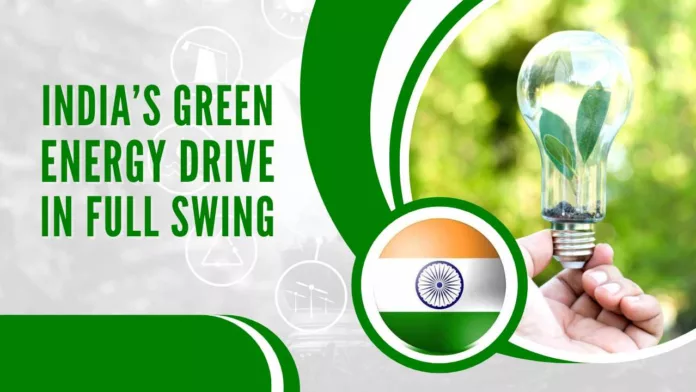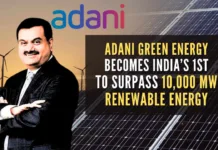
India’s Green Energy Roadmap 2030 and corporate sector’s contribution
Power and New & Renewable Energy Minister R K Singh said this week that India needs to develop but will do so “responsibly”, which is reflected in the country being nine years ahead in achieving the nationally determined contributions (NDC) target set under the Paris Agreement on Climate Change of having 40 percent of installed power capacity from non-fossil fuel sources by 2030.
“We pledged at COP-21 in 2015, that we will reduce our emissions intensity by 33 percent by 2030; we did this by 2019. In COP 26 in Glasgow, we have said that by 2030, we will have 50 percent of our capacity coming from renewables and that we will reduce our emission intensity by 45 percent. We will achieve it. So, we are on target,” Singh told journalists in Delhi while explaining India’s position in the run-up to COP-28.
He also said that the success is based on the fact that India is adding renewable energy capacity at the fastest rate in the world.
Switching to renewable energy holds the key to reducing the carbon footprint and achieving net-zero goals. In order to achieve its ambitious goal of 500 Gigawatt (GW) of renewable capacity by 2030, the government has also been vigorously promoting the adoption of electric vehicles, the production of green hydrogen, the manufacturing of solar equipment, and the development of energy storage.
Singh’s overview is backed by a lot of action on the part of corporates in the country with the largest amongst them taking a plunge into green energy with massive investment plans.
Reliance Industries is accelerating its green energy initiatives with the aim to make India a world leader in energy transition. The company has set the ambitious target of installing at least 100GW of renewable energy generation by 2030.
“We remain focused on fast-track execution of our Dhirubhai Ambani Green Energy Giga Manufacturing Complex at Jamnagar,” said RIL CMD Mukesh Ambani at the company’s 46th AGM this year.
The richest Asian said the company will invest in its own production capabilities and new technologies and also collaborate with global technology and product companies. The priority would be to deliver a fully integrated, end-to-end solar PV manufacturing ecosystem, which is expected to be completed by the end of 2025.
Similarly, Adani Green Energy has drawn up plans to invest $3 billion in the next 5-7 years and is backward integrating its operations through the electronic manufacturing cluster at the Mundra seaport.
Adani Green Energy MD and Director Vneet Jaain said that they are currently at 4GW and plan to increase capacity to 10GW by 2027.
Among the older players, Suzlon is a market leader with 111+ wind farms and an installed capacity of over 14.3 GW. The company has developed some of Asia’s largest operational onshore wind farms in nine states including Gujarat, Rajasthan, Maharashtra, and Tamil Nadu.
Clean energy company ReNew, which has a 13 GW solar and wind capacity, claims to have managed to avoid over 14 million tonnes of carbon emissions during the fiscal year ended March 31, 2023. According to its ‘Third Sustainability Report: Driving Decarbonisation,’ the company also saved 3.18 lakh kilolitres of water during FY23. ReNew’s net-zero targets by 2040 were validated by SBTi.
As part of the fight against climate change, auto majors such as Tata Motors and Mahindra & Mahindra have started producing electric cars while the government is also pushing for foreign vehicle makers such as US giant Tesla to set up production facilities in India. A new policy to offer them more incentives is on the anvil.
Indian Railways has electrified its network intending to become a net zero carbon emitter by 2030. Rapid electrification of the railway network has enabled the switch from diesel locomotives and the last portion of electrification of over 6,000 route kilometres is being completed in a record six months till December-end.
To reach its 500 GW goal by 2030, India would have to continuously add at least 25 GW of renewable energy capacity every year for eight years. India currently has about 173 GW of clean energy capacity based on non-fossil fuels, including 62 GW of solar, 42 GW of wind, 10 GW of biomass, 5 GW of small hydro, 47 GW of large hydro, and 7 GW of nuclear power.
However, while India pushes ahead in the fight against climate change there is also a feeling that the Western countries are trying to arm-twist the developing countries on the issue. Power Minister Singh is also of the view that it is the developed countries who need to cut down their emissions first.
Explaining India’s position, the Minister said, “The developed countries used fossil fuels for developing their economies but they want to tell us that we should not use coal.”
“Around 85 percent of the carbon dioxide load in the atmosphere is due to the path of industrialization followed by developed countries. India’s population is 17 percent of the world population while our contribution to carbon dioxide load is only 3.5 percent. Even now, our per capita emissions are one-third of the world average, while that of developed countries is three times the world average,” Singh told journalists.
[With Inputs from IANS]
For all the latest updates, download PGurus App.











Break the back of middle east by switching to green fuel & more importantly the backbone of Qatar.